External structure of the bee’s body
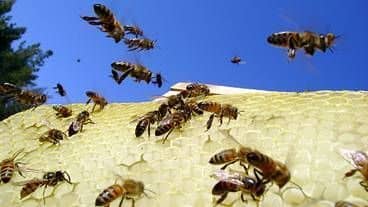
Outer cover.
Bees, like all insects, do not have an internal bone skeleton, which in vertebrate animals represents the basis and support of the whole body. Instead of the internal skeleton, bees have a hard outer covering, which serves to attach muscles and protect internal organs.
In the outer cover, you can distinguish three layers of the outer hard chitinous layer (cuticle); it is formed by the second (cellular) layer and is the outer dead layer of a cellular layer consisting of flat or almost cubic living cells, closed together.
It is an integral part of the outer cover and reproduces all its bends and irregularities, the muscular layer causing some mobility of individual dense parts of the skin.
The cover is divided into hard rings (segments) joined by a soft skin; this connection provides the bee with freedom of movement. Each ring (segment) consists of two semirings or plates: the dorsal and ventral, connected along the sides.
From the outer chitinous cover, the chitinous processes that extend into the body also serve to attach the muscles, and therefore they are called the inner skeleton.
Bees, like many other insects, discard the outer cover (moult) only in the larval stage of their development.
Hairs. The whole body of bees is covered with hairs consisting of the same chitin. They are small outgrowths of the outer cover. The shape of the hairs is very diverse, for example, single, bristly, pinnately split, etc. Some hairs, very soft, are sensitive, they are organs of touch. Other, pinnate, especially suitable for collecting pollen and distributed throughout the body of the bee. Still others play the role of a brush on the body of a bee. The fourth serves to preserve warmth and protection, the fifth serves to keep pollen and so forth.
The color of the cover itself is mainly black, slightly shiny. Covering his hairs give him a grayish look.
Young
Flying from one flower to another and transferring due to the presence of hairs on its body pollen, bees promote cross-pollination of plants.
The body of the bee consists of three parts: the head, chest and abdomen. At the same time, the head connects with the breast with a short, thin neck, and the chest with the abdomen – a thin solid stalk.
Head.
The head of the bee is flattened from the side of the chest. The drone is almost round, the uterus has a more cordate shape, while the worker’s bee is almost triangular.
On the head are eyes, antennae and mouth with their appendages.
Eyes.
The bee has five eyes: two eyes are complex, or faceted, located on the sides of the head, and three eyes are simple, single, placed in the upper part. Complex eyes consist of not less than 4 000 (and in queens and especially in drones from more) small eyes (facets). It is believed that complex eyes serve a bee to distinguish distant objects in flight activity of bees, and simple eyes are needed for it when working in a hive or on a flower to view close objects.
The drone has complex eyes so large that they touch on the crown, and simple eyes are moved far ahead, so that they almost reach the antennae.
Each hole of the complex eye is a long, tapering to the end, a tube whose walls consist of cells filled with a dark opaque substance – a pigment. The eyelet consists of an outer transparent hexagonal slightly convex cornea, or lens, to which the crystal cone adjoins its base; the vertex of the cone rests against a long, glassy rod reaching the base of the eye, which is surrounded by 6-8 photosensitive cells. From these cells go to the brain nerves. Thus, the complex eye consists, as it were, of a multitude of tubes that are covered with pigment cells that do not transmit light.
In a complex eye, the opposite is obtained, but a direct, reduced image of the object. The image from a moving object is quickly transferred from one group of eyes to another, and therefore the bees perceive moving objects-it is easier than stationary ones.
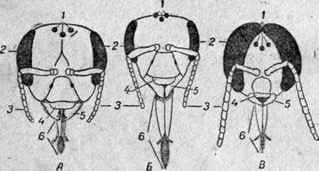
Fig. 4. A-head of the uterus; B – working click and B – drone.
1 – simple eyes; 2 – complex eyes; 3 – antennae; 4 – upper lip; S – upper jaw; 6 – proboscis.
Simple (single) eyes of the bee are built on the principle of a photographic camera.
A simple eye is placed in the deepening of the cellular layer of the skin. It consists of a biconvex chitin lens (cornea), a large convexity that faces the eye. From the bottom of the lens there is a layer of low transparent cells, called lens cells.
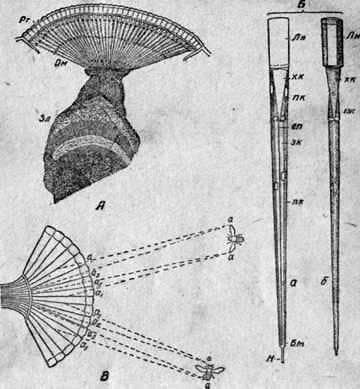
Fig. Difficult eye of a working bee:
A – longitudinal section through the complex eye and the visual lobe of the supra-pharyngeal node; R – cornea; Om-ommatidium; Zl is the visual lobe. B – structure of omatidia: a – longitudinal section; b- appearance of ommatidia; A is the lens; Xk is the crystal cone; Pc – outer layer of pigment cells; Cn is a vitreous stick; 3n – visual cells; H is the nerve. B – refraction of the rays in the complex eye of the bee: the rays incident to the ommatidia at an angle, are absorbed by the pigment cells; rays are refracted by ommatidia.
From the sides, the lens is surrounded by a ring of tall cylindrical pigment cells, permeated with a black dye. They are considered a light absorbing apparatus.
Behind, to the transparent cells of the lens, there is a layer of elongated photosensitive (visual) cells connected from below with nerve fibers that go to the brain. The lens of a simple eye gives the reverse image of an object in a reduced form.
Antennae.
Antennae in bees are attached to the head from the front and can move in all directions. They consist of a working bee and uterus from one large joint, called a trunk, and 11 small ones, constituting the so-called flagellum. In the drone, the flagellum consists of 12 segments. Consequently, the tendril of the worker bee and uterus consists of only 12 segments, and the drone out of 13.

Fig. 6. The structure of a simple eye:
1 – the lens; 2-pigment cells;
3 – visual cells; 4 – nerve fiber.
On the antennae, especially on the eight terminal segments, there is a mass of sensitive cells. In the middle of the antennae there are trachea and nerve, which branches into many nerve fibers. From small depressions, tender chitinous hairs rise, into which the appendages of sensitive nerve cells enter from below. Thus, outside the antennae are covered with sensitive hairs and dotted with an extremely large number of dimples, tightened with delicate membranes.
Antennae in the bee are an important organ of smell. Without them, bees can not find food by smell. Without beards, bees can not live long and will soon die.
Mouth.
The bee’s mouth consists of the following parts: the upper lip, a pair of upper jaws, or a pair of lower jaws with tentacles, a lower lip with a long outgrowth called a tongue.
The mouth of the bee, like other insects, is not at all like the mouth of higher animals. All the appendages of the mouth, such as jaws, tentacles, tongue, are not in the mouth, but encircle the hole through which the food passes.
Oral opening is a transverse slit located in the narrowest part of the head, and surrounded by oral parts. These include: upper lip, upper jaw, lower jaw, lower lip and tongue.

Fig. 7. Mouth parts of a working bee:
/ – head of the worker bee: 1 – simple eye; 2 – complex eyes; 3 – antennae; 4 – upper lip; 5 – mandibles, or upper jaws; 6 – lower jaws; in, the tentacles of the lower jaws; 7 – tentacles of the lower lip; 8 – tongue, 9 – spoon. II – the end of the tongue with the spoon, III – the arrangement of the lower jaws (6), the tentacles of the tongue (7) and the tongue <8) at the time they make up the tube when collecting nectar (cross-section).
The upper lip is a fold of the skin, which, hanging danglingly, covers the mouth from above.
Upper jaws are two short curved blades of dark color. They are placed on the right and left along the edges of the mouth. These jaws move horizontally and serve to gnaw out not particularly solid objects. For example, bees freely gnaw through the caps of cells, gnaw out queen cells and honeycombs with spoiled perga, knead wax and pollen, grasp and pull out dead bees, and gnaw the legs and wings of bee-throats, wasps. The upper jaws of the uterus are more developed; they have one sharp tooth, so the uterus can quite smoothly cut off the lid of the printed queen before exiting it.
The upper jaws are set in motion by strong muscles lying in the head.
The remaining parts of the mouth, such as the lower jaws, tentacles and tongue, are the longest appendages of the mouth and serve to lick and suck out the sweet juices, for example nectar from flowers, padi from leaves, etc.
The lower jaws consist of such basic parts as the lower chin, trunk, inner lobe and outer lobes.
Behind the lower jaws is the so-called lower lip with tongue and tentacles.
Lower lip and tongue.
The lower lip of the bees also consists of two paired parts, fused together.
On the lower lip distinguish the lower chin and chin. From the base of the chin go down: a long, soft and fairly flexible, pubescent process, the so-called tongue, which was formed as a result of the fusion of parts of the lower lip. On the sides of the tongue are, two small prigozhichnik and a pair of long articulate tentacles, the so-called lower lobe. On the back side of the tongue in the middle is a groove. The bent edges of the groove closely adjoin each other. The tip of the tongue ends with a round lobe – a spoon densely covered with tender hairs.
At the base of the tongue are the organs of taste.
The lower jaws, the lower labial tentacles and the tongue form, as it were, a tube called the proboscis. The proboscis serves to collect nectar from flowers. The worker’s bee is considerably longer than the uterus and the drone, who do not have to collect nectar. In a calm state, the proboscis folds and hides beneath the head.
The length of the proboscis in bees of different “rocks” is not the same.
Proboscis of the uterus is 3.5 mm, and the drone is about 4 mm.

Fig. 8. Lower mouth parts of the bee:
Hq – lower jaw; Schia – the tentacles of the tongue, or the so-called lower lip tentacles; I am a tongue; L – a spoonful of tongue; э is the tentacle of the lower jaw; Pa – suspension apparatus.
The sucking out of the flower nectar is as follows. As soon as the bee puts the spoon of the tongue into the liquid, immediately this liquid, due to capillarity, begins to rise with the smallest trickles up between the hairs and along the groove of the tongue. In this case, the liquid reaches the tube, which is formed from the tongue, the lower labial tentacles and the lower jaws, covering the tongue from all sides, causing a hermetically sealed space or tube around it. This tube with the help of the appropriate muscles can expand, increasing in diameter. At the moment when the bee arbitrarily expands the tube, the latter is vacuumed (“emptiness”), and therefore the liquid under the pressure of the outside air rises quickly upward. That squeezing, then expanding this tube, the bee causes more and more quantities of fluid to rise.
When there are only traces of fluid, the bee does not suck, but simply lickens them.
Chest.
Chest – the middle part of the body. Insects usually consist of 3 segments – anterior, middle and posterior, but in the bee it consists of 4 segments.
If the first three segments are considered as real thoracic segments, and the fourth as intermediate. These parts are so closely merged with each other that they can hardly be discerned. The breast is extremely densely covered with hairs. The first segment of the abdomen narrows and forms a so-called stem, which merges with the breast and, thus, attaches the abdomen to the chest.
To the breast are attached two pairs of wings and three pairs of legs. The anterior segment of the breast is the least developed and carries only the front legs of the bee. On the middle there are the first pair of wings and the second pair of legs. The middle segment is very developed. It is a receptacle of extremely strong muscles, which move the wings and legs. On the posterior segment are the second pair of wings and the third pair of legs. This part is less developed than the middle one.
The legs of the bee consist of the following joints, located one after the other: 1) the thigh, which is the first joint serving to connect the leg to the chest, 2) the swivel, 3) the hip, 4) the shin and the foot, which in turn consists of five segments. The first segment of the foot is much larger than the other four segments and is called the tarsus or tarsus. The rest of the foot consists of four small segments,
The foot ends with a claw segment bearing a pair of double claws. Between them there is a pad that emits an adhesive liquid that increases the adhesion to smooth surfaces. This circumstance, as well as the ability of the cushion sole to protrude and retract, allows the bee to walk on smooth slippery objects, glass, ceiling, etc.
Claws of hind legs are necessary for the uterus when laying eggs. If the uterus is damaged by claws on one leg, the uterus is not able to lay, many eggs, and sometimes puts them wrong. With the loss of claws on both hind legs, the uterus is completely deprived of the opportunity to lay eggs, as it has nothing to gain by the edges of the cells in order to lower the abdomen into the cell.
In addition to its direct function, the legs of the bee play an even greater role in the cleaning of the antennae and the body, in the construction of honeycombs and in the collection of pollen. Flying from flower to flower, the bee is heavily dusted; pollen is stuffed everywhere between hairs, densely covering its body. Even the eyes and antennae are dusty. To get rid of pollen, the bee cleanses itself with the help of its legs, on which there are appropriate devices – brushes.
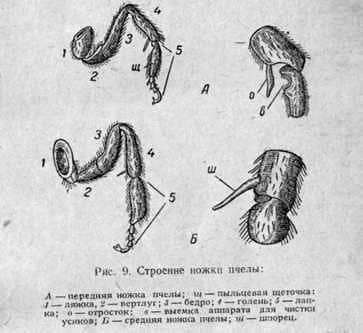
The anterior pair of legs of the worker’s bee, uterus and drones are arranged identically. It serves to walk and to clean the front of the body, head, eyes and antennae. On the anterior segment of the foot there are dense rows of hairs on the inside, which form a so-called brush, resembling a scallop rather. With this brush, the bee sweeps away the pollen from the head and eyes.
To clean the antenna, these legs have a special device, consisting in the fact that in the upper part of the anterior segments of the foot there is a semicircular groove, or a cut, seated with blunt bristles like a scallop. Below the lower leg there is an appendage, the so-called valve, which, when the leg is bent, covers the scallop, thus forming a semicircular aperture. For. cleaning the mustache of the bee puts it into the cutout, locks this cutout with a valve and cleans the tendril from pollen and other foreign matter.
The middle pair of legs has the same arrangement in all three individuals of the bee family. The peculiarity of this pair of legs is that in the lower corner of the shin there is a point called a spine or a spur. The spur serves as a worker’s bee to drop pollen into the cells, brought by a bee on its hind legs.
The back pair of legs of the working bee has a brush for sweeping the pollen off the body, a basket for folding and carrying pergs and tweezers.
Drones and uterus do not collect pollen and do not secrete wax; in this regard, on the back legs they have no baskets or tweezers.
The basket is located on the outside of the lower leg and is a small oblong depression, seated along the edges with sparse, slightly curved hairs, thanks to which more pollen is placed in the basket.
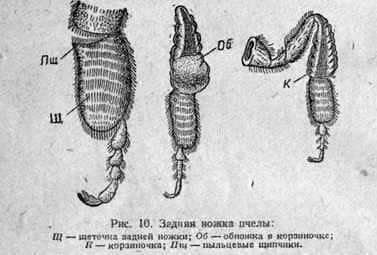
Sweeping the pollen off the body, the bee folds it into a basket. Pollen in the basket of pollen in the form of a lump is called an update.
Tweezers are formed at the junction of the tibia and anterior segment of the foot, with the lower edge of the shin seated around with long sharp hairs-teeth (pollen scallop), and the upper margin of the tarsely slightly hairy.
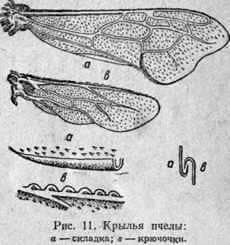
Using a bristly brush of the first segment of the foot, the bee removes wax plates from the lower part of the abdomen, which pours to the mouth, moistens with saliva, kneads jaws and molds honeycombs from them.
Wings. In addition to the legs, wings are attached to the breast. Bees have two pairs of wings. The front wings are much larger than the rear wings.
According to the severity and massiveness of the body, the size of the wings is not the same: in the drone they are the largest, the smaller ones in the uterus, and somewhat less in the working bee.
The bee wings are studded with sparse small hairs and permeated with chitinous veins, which look like tubules coming out from the base of the wing. Stronger veins are in front, where the air resistance is greatest, and the weaker ones are behind.
In a calm state, the rear wings of the bee are under the front and. adjacent to the body, which gives the bee the ability to climb into the cell. When flying, both wings form one surface.
The connection, or grip, of the wings occurs with the help of the rear edge of the front wing, folded and forming a fold, the front edge of the rear wing, on which there is a series of hooks, clings into it. With these hooks, the rear wing hooks on the fold of the front.
Wings are attached to the body of the bee by means of complex joints in the place where the center of gravity of the body is located. The motion of the wings is so fast that they are almost indistinguishable. According to the research of our scientists, the bee makes from 90 to 440 strokes (oscillations) per second. Simultaneously with the vertical movements (flaps) of the wing, some more rotational movements are made, which are necessary to change the direction of the flight and move forward.
Since the wings are attached to the chest and the legs are doing a great job, the breast is provided with a strong (developed muscles.) In addition to its own weight (0.1 g), the bee can carry another 3/4 of this weight in the form of honey and pollen The bee without cargo flies at a speed of up to 65 km per hour, and with cargo from 19 to 32 km. With the flight, the bee can quickly stop or accelerate forward, it can quickly rise up or fall down, or turn into side when encountering an obstacle.
Abdomen.
The abdomen of the worker’s bee and uterus consists of clearly discernible six chitin rings, and the drone of seven. The chitinous rings are arranged in tile form and decrease in size toward the end of the abdomen. Each ring consists of two semirings, arched bent dorsal and slightly convex abdominal, connected on each side by a soft skin.
A thin elastic sheath connects one ring to another and allows them to be retracted one into the other, causing the body of the bee to become longer, then shorter. The abdomen can also thin out and thicken, depending on whether the dorsal shields cover the abdominal half rings more strongly or looser.
The abdomen of the uterus has the shape of an almost regular cone, and during egg laying it significantly increases in volume and lengthens. The abdomen of the abdomen is thick, behind is rounded and densely covered with hairs.
On the abdomen, the bees are: on top – Nasonov’s glands; from below inside – waxy glands; on the sides of a spiracle, or stigma, and on the last segment of the abdomen-it was pressing.
Nasonov’s glands lie under the soft connective skin, between the 5th and 6th abdominal rings. When the bee stands in front of the bow with a raised abdomen, whose end is slightly bent, the glands are visible as a transverse strip of light gray color. It is believed that these glands produce odorous substances that cause the smell of bees and nests.
Voskovnitsy. Abdominal lower half-rings of bees partially cover one another. In this case, the free outer part of the semicircle is thick, hard and densely covered with hairs, and the part, which is under the cover of the other half-ring, does not have hairs and is tender.
The working bee has on the last four (starting from the 3rd ring and ending with the 6th) the half-rings of the abdomen over a pair of so-called wax mirrors, or waxy ones, covered from above with the hairy part of the previous half-ring. Consequently, on the four semirings there are eight such mirrors, which are enclosed in thicker chitinous frames. The wax emitted by the wax glands under the mirrors passes through the cuticle outward in a liquid form and then hardens in the air. Very thin pentagonal wax plates are obtained. During the construction of honeycombs, it is often necessary to see bees, from which eight wax plates stand out from wax-boxes, like eight pockets. Uterms and drones do not work out wax, and therefore they do not have wax-separating glands and mirrors.
In young bees, which just emerged, the cells of the wax glands are not yet fully developed. As the bee grows and grows older, these cells are lengthened and the smallest droplets of wax are formed. The developed wax glands consist of high cylindrical cells lying in pairs. When the bee grows old, the cells decrease in size and the ability to excrete wax shrinks.
In autumn and winter, under normal wintering conditions, the wax glands are at rest and no wax is released. If the glands have not developed at all or have developed poorly since the autumn, then their normal development and waxing begins in the spring. Completely developed since the autumn and then ceased their activity of the gland almost does not renew it in the spring.
Young bees, feeding the brood, eat well themselves and therefore give more wax.
Sting.
Uterine and working bees have a well developed sting, and drones do not have it. The sting of a bee consists of immobile chitinous parts, which are grouped around the middle part of the so-called sled, and of two thin, moving inside the sledge, inside hollow, piercing needles or stilettos, which have 9-10 reversed crochets at the end. Styles are associated with chitinous plates, the movement of which with the help of muscles determines the movement of these needles.
The stinging apparatus has well developed musculature.
To attach the muscles that move the sting, the bee has three pairs of side plates located on the sides of the stinger – triangular, square and oblong or covering, which at the end has soft outgrowths, called tentacles or a case. Tentacles covered with sensitive hairs.
Intending to sting, the bee first bends down the end of the abdomen to bring the sting closer to the body of the enemy. Then, with the action of strong muscles, the papillary apparatus is pushed out of the end of the abdomen, and the end of the sled pierces the skin. At the same moment, one, and then another, sticks into the wound.
When the warm-blooded animals are stung, the bee can not pull back the sting, and when trying to do this, it even more deeply pierces it. As a result, the stinger breaks off; while the internal organs and the nervous system of the bee are damaged, and as a result, sleep soon dies. Even having separated, the stinger continues to work for a while.
When stinging insects, the cover of which is not elastic, the bee usually easily removes the sting. The wound from the injection of the bee sting is very small. Therefore, the pain of stinging does not come from the very injection, but from the penetration of poison into the wound.
The poison is produced in the large iron-deficiency gland and accumulates in its venous bladder.
From the poisonous bladder a short duct emerges, which opens in the extended part of the saddle of the sting.
Next to it opens the second so-called small poisonous gland in the sled, having the form of several. convoluted tube. Thus, the composition of the poison includes you dividing the two poison glands.

When a bee with a contraction of muscles activates a sparing device, that is, sticks a stinger into the body, pressure is simultaneously applied to the bubble, which causes the drop of poison to flow out of it and through the channel formed by the sled and stylet stings, falls into the wound.
The sting of the uterus is similar in structure to the sting of a worker’s bee, but it is much larger in size. Sleds and needles curled saber-like downwards. There are 3 to 5 denticles on the needles.
The uterus uses its sting only against its “rivals,” that is, other queens.
The chemical composition of bee venom is very complicated.
The pain caused by the bee’s stinging is quite strong, but not long, especially for people involved in beekeeping. In unaccustomed people, stinging causes considerable swelling.
Bee venom can be dangerous to humans only in rare cases, with simultaneous stinging by many bees. At the same time, there are many examples of curing rheumatic diseases resulting from stinging by bees. The use of bee venom for medicinal purposes should be done under the supervision of a doctor.
External structure of the bee’s body
